Are you looking for a new coin to add to your collection? If yes, you must consider having the 1973 half dollar coin. It is an old coin and carries a great numismatic value. Continue reading this article and learn about the history, value, and composition of the 1973 half dollar coin.
What Is the 1973 Kennedy Half Dollar Made Of?
The 1973 Kennedy half dollar is made of 75% copper and 25% nickel. The coin is clad with nickel, and its core is pure copper. However, the Kennedy half dollar was initially made of 60% copper and 40% silver, produced from 1965 to 1970. Also, on the first year the Kennedy half dollar was struck, it was made of 90% silver and 10% copper.
The 1973 Kennedy 50-cent coin has 150 reeds on its rim. It has a weight of 11.30 grams and a diameter of 30.61 millimeters.
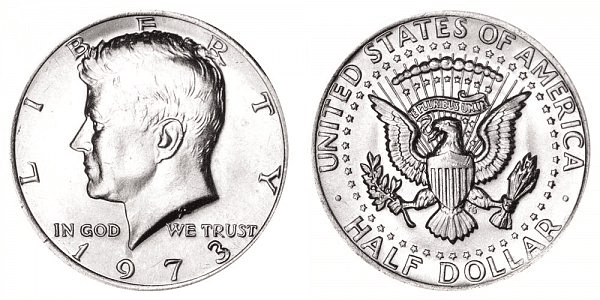
When it comes to the design, the 1973 half-dollar coin’s obverse features the image of the fallen leader, John F. Kennedy, the 35th president of the United States. A portion of Kennedy’s hair partially covers the word LIBERTY. Below his image runs the US motto, “IN GOD WE TRUST.” at the bottom of the coin, you’ll find the year of minting, 1973.
On the reverse, you’ll find the modified presidential seal. It has the heraldic eagle with its wings outspread. The eagle is holding a banner in its beak that says, “E PLURIBUS UNUM,” Latin for “Out of many, one.”
On the left talon, the eagle holds an olive branch, which signifies peace; on the right talon, the eagle holds 13 arrows representing the first 13 colonies of the State. In front of the eagle is the Union shield. Around the eagle are 50 stars representing all the country’s states. Inscriptions include UNITED STATES OF AMERICA and HALF DOLLAR.
The 1973 half dollar is part of the Kennedy half-dollar series that the US Mint first issued in 1964. After the tragic assassination of Kennedy in 1963, Congress moved immediately to honor the assassinated leader and add him to the half dollar coin, essentially replacing the Franklin half dollar.
The swift approval of the Kennedy half dollar was record-breaking for a US coin. Gilroy Roberts and Frank Gasparro used their existing work to quickly produce the design of the new half dollar.
The Kennedy half dollar was made of silver when it was first released in 1964. A great number of the coins were hoarded. The new Kennedy half-dollar coin was so popular that some pieces even reached abroad.
As a response, the US Mint increased production of the half-dollar coin, but to no avail; it was still rarely seen in circulation. Aside from that, some people melt the Kennedy half dollar for its silver.
All these led the US Mint to decrease the half dollar’s silver content, from 90% to 40%. However, that didn’t help either. So, finally, in 1971, silver was completely removed from the Kennedy half dollar.
1973 Kennedy Half Dollar Varieties
The 1973 Kennedy half dollar has three varieties, which differ in the manner of their strike and their min mark. Here’s a quick look at the varieties of the 1973 Kennedy half dollar coins, along with their mintage:
| Variety | Mint Location | Mintage |
| 1973 P Kennedy Half Dollar | Philadelphia | 64,964,000 |
| 1973 D Kennedy Half Dollar | Denver | 83,171,400 |
| 1973 S Proof Kennedy Half Dollar | San Francisco | 2,760,339 |
| Total | 150,895,739 |
The Philadelphia and Denver Mints produced the regular half dollar coins, while the San Francisco Mint produced the proof coins. The US Mint produced more than 150 million half dollar coins in 1973.
Let’s now have a deeper look at each of the 1973 Kennedy half dollar coins:
1973 P Kennedy Half Dollar
Year of minting: 1973
Mint Mark: none
Place of minting: Philadelphia
Quantity produced: 64,964,000
Face Value: $0.50 (fifty cents)
Price: $0.60 to $0.75 (circulated condition)
Mass: 11.30 grams
Diameter: 30.61 millimeters
Edge: Reeded
Designer: Gilroy Roberts/Frank Gasparro
Composition: 75% Copper, 25% Nickel
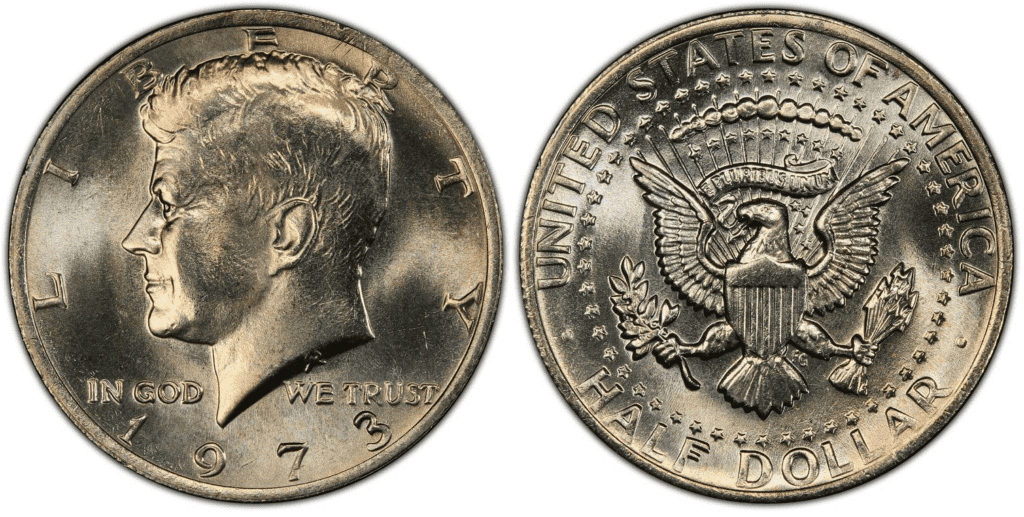
The Philadelphia Mint produced almost 65 million 50 cents in 1973. The Mint did a great job striking half-dollars; most of what they produced came out with better detail and luster. As a result, you should easily find 1973-P half dollars in grades up to MS65.
MS66-graded half dollars may be a little difficult to find, but you should still be able to find one if you look harder. Any coin with a grade above MS67 is considered rare and carries a great premium.
1973 D Kennedy Half Dollar
Year of minting: 1973
Mint Mark: D
Place of minting: Denver
Quantity produced: 83,171,400
Face Value: $0.50 (fifty cents)
Price: $0.60 to $0.75 (circulated condition)
Mass: 11.30 grams
Diameter: 30.61 millimeters
Edge: Reeded
Designer: Gilroy Roberts/Frank Gasparro
Composition: 75% Copper, 25% Nickel
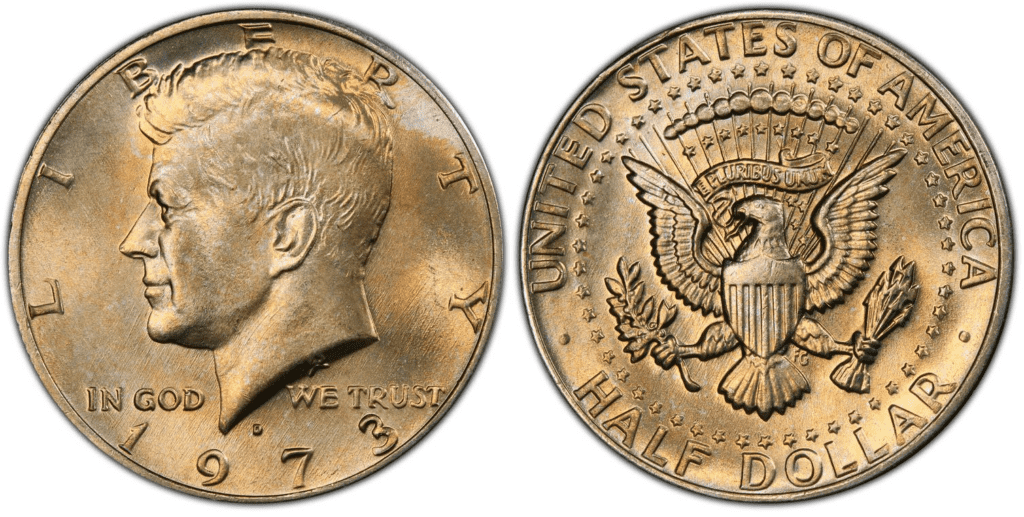
With over 83 million 50-cent coins minted, the Denver Mint issued the most 1973 half dollar coins. Each of the half-dollar coins from the Denver Mint has the mintmark “D.”
1973 S Kennedy Half Dollar
Year of minting: 1973
Mint Mark: S
Place of minting: San Francisco
Quantity produced: 2,760,339
Face Value: $0.50 (fifty cents)
Price: $12 or more (uncirculated condition)
Mass: 11.30 grams
Diameter: 30.61 millimeters
Edge: Reeded
Designer: Gilroy Roberts/Frank Gasparro
Composition: 75% Copper, 25% Nickel
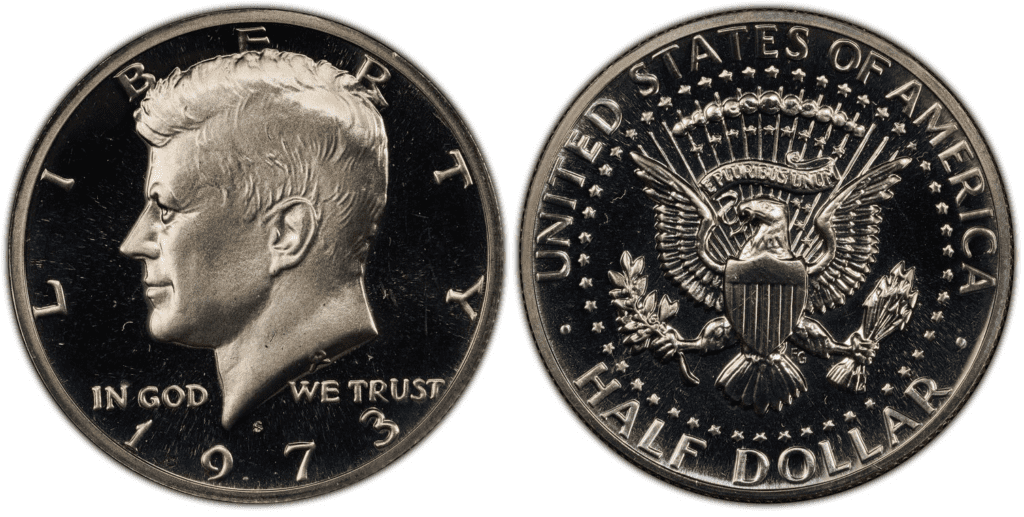
There was a great demand for half dollar proof coins in 1973. Thus, the San Francisco Mint made more than 2.7 million proof half dollar coins to meet the demand.
List Of 1973 Kennedy Half Dollar Errors
Among the most interesting parts of collecting US coins is getting a copy of an error coin. They are unique and could be sold for more than their face value. So, if you’re interested, take a look at these 1973 Kennedy half-dollar errors:
Doubled die error
The doubled die error happens when the die hits the blank coin more than once. Because of the fast and continuous strikes of the die, sometimes, the planchet doesn’t leave the die collar quick enough to avoid the second strike.
Usually, doubled die errors aren’t that obvious. You even have to use microscopes or magnifying glasses to find them. That’s why the more prominent a doubled die error is, the more they become valuable.
Take a look at this 1973 Kennedy half dollar with a doubled die error:
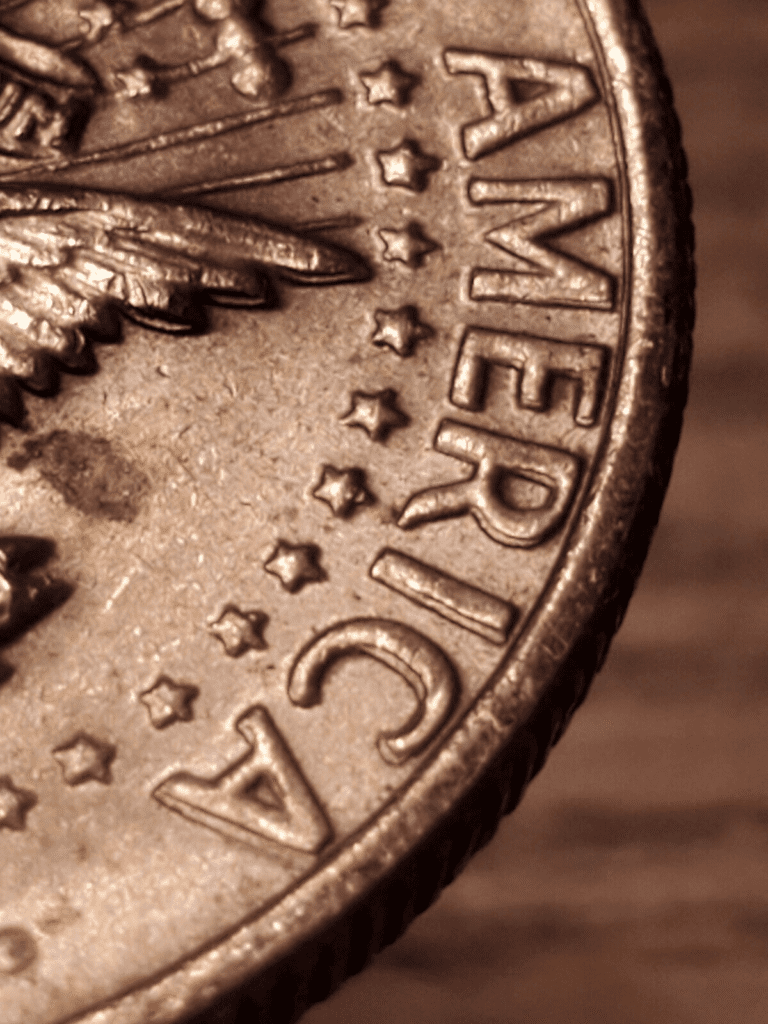
You will see a doubling effect on the letters and even on the eagle’s wings.
No FG error
The half dollar has the letters FG on the reverse side of the coin, just between the right leg and tail of the eagle. In this error, the FG, which is the initials of Frank Gasparro, is missing.
Here’s an example:
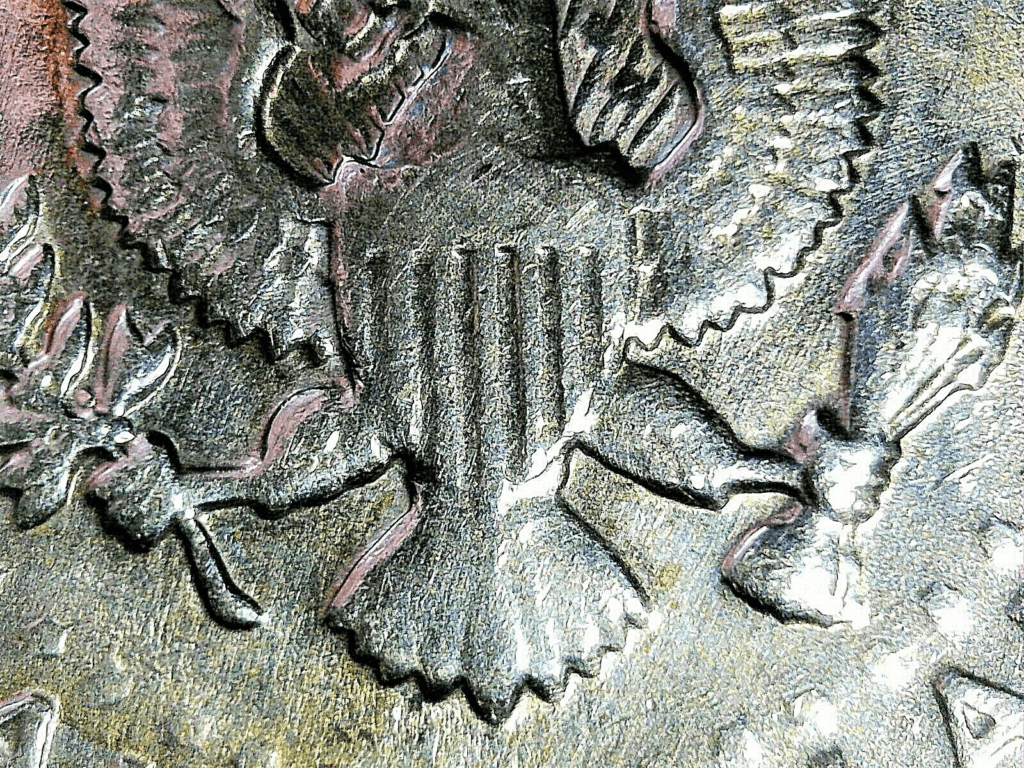
Cud error
The cud error happens when a portion of the die is chipped away due to wear and tear. Because of this, the die now has a distorted area that when it hits the planchet, it manifests itself as a cud or bubble on the coin.
Here’s an example of a cud error on a 1973 half-dollar coin:
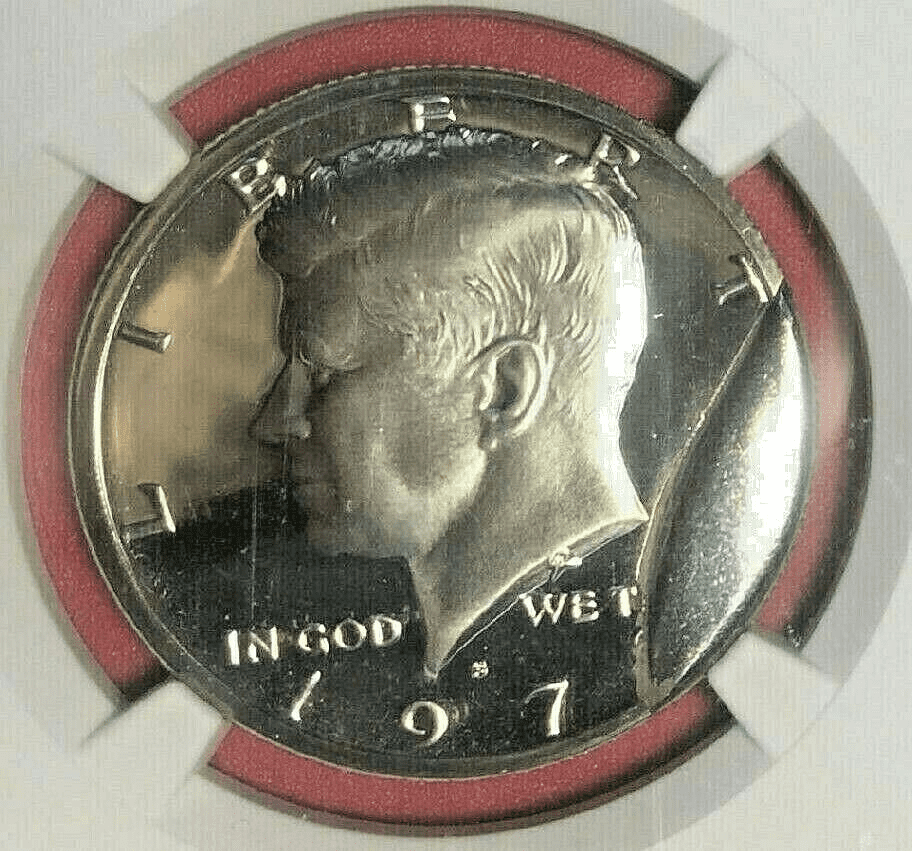
How Much Is 1973 Kennedy Half Dollar Worth Today?
The 1973 Kennedy half dollar has a face value of 50 cents. The melt value is just about $0.1154. A circulated 1973 half dollar may be below one dollar.
1973 Kennedy half dollars are astronomically more valuable than its melt and face value. Take a look at these auction records:
| Coin | Condition | Grade | Sold date | Sold by | Value |
| 1973 P Kennedy Half Dollar | Superb Gem Uncirculated | MS 67 | April 16, 2022 | eBay | $1,400 |
| 1973 D Kennedy Half Dollar | Uncirculated | MS 62 | January 9, 2013 | Heritage Auctions | $1,704 |
| 1973 S Proof Kennedy Half Dollar | Perfect Uncirculated | PR 70 – Deep Cameo | April 26, 2006 | Heritage Auctions | $4,888 |
How Does The Grading System Work?
Professional numismatists joined in the 1970s and established CoinGrading standards, known as the Sheldon Scale. These numismatists now assign grades at key places on the seventy-point scale, using the most regularly utilized numeric points in conjunction with the original adjective grade. The following are the most common coin grades:
- (P-1) Poor – Indistinguishable and probably damaged; if used, must have a date and mintmark; otherwise, rather battered.
- (FR-2) Fair – Nearly smooth, but without the damage that a coin graded Poor often possesses. The coin must have enough detail to be identified.
- (G-4) Fair – Inscriptions have merged into the rims in some areas, and important elements have been mostly erased.
- (VG-8) Very Good- A little weathered, but all primary design elements are visible, albeit faintly. There is little, if any, central detail left.
- (F-12) Good – The item is very worn, yet the wear is even, and the overall design details stand out clearly. Rims are almost completely isolated from the field.
- (VF-20) Very Fine – Moderately weathered, with some finer features still visible. The motto or all letters of LIBERTY are readable. Both sides of the coin have entire rims separated from the field.
- (EF-40) Extremely Fine – Gently used; all gadgets are visible, and the most important ones are bold. The finer details are bold and clear; however, light wear may be seen.
- (AU-50) Uncirculated – Slight evidence of wear on the coin’s design’s high points; it may have contact marks; eye appeal should be adequate.
- (AU-58) Uncirculated Choice – Slight traces of wear, no severe contact marks, almost full mint shine, and great eye appeal.
- (MS-60) Mint State Basal – Strictly uncirculated; no indication of wear on the coin’s highest points, but an unsightly coin with reduced luster, visible contact marks, hairlines, and other flaws.
- (MS-63) Mint State Acceptable – Uncirculated, but with contact scratches and nicks, little reduced shine, but otherwise appealing appearance. The strike is weak to average.
- (MS-65) Mint State Choice – Uncirculated with great mint shine, little contact blemishes, and exceptional eye appeal. The strike is unusually severe.
- (MS-68) Mint State Premium Quality – Uncirculated with superb luster, no obvious contact marks to the naked eye, and exceptional eye appeal. The strike is quick and appealing.
- (MS-69) Almost Perfect Mint State – Uncirculated with perfect brilliance, a sharp and appealing strike, and extremely good eye appeal. A near-perfect coin with minor imperfections in the planchet, strike, and contact markings (seen only under 8x magnification).
- (MS-70) Mint State Perfect – Under 8x magnification, no tiny imperfections are discernible; the strike is crisp, and the coin is perfectly centered on a beautiful planchet. Rarely seen on a coin, this coin is bright and whole, with original luster and exceptional eye appeal.
Where To Buy Or Sell 1973 Kennedy Half Dollar?
If you’re trying to buy or sell a 1973 Kennedy half dollar, you should try the Internet. Just a quick Google search and you’ll find hundreds of websites that could help. For example, use the search term “Buy 1973 Kennedy half dollar” or “Sell 1973 Kennedy half dollar.”
Most likely, the most popular websites you’ll find would include Amazon, eBay, Etsy, USA Coin Book, and Coin Appraiser, to name a few.
Aside from the Internet, you can try coin shops and local or national coin dealers. Try to ask PCGS, NGC, and other coin-grading service providers. They should be able to point you in the right direction. Visit auction houses, pawnshops, and antique stores. You could find 1973 half dollars from these places if your timing is right.
FAQs
What makes a 1973 half dollar rare?
The 1973 half dollar is not rare. There were 150 million half dollar coins that were produced in 1973. However, 1973 half dollars in top grades, beginning from MS67, would be considered rare since only a few exist. Some error 1973 half dollar coins could also be rare.
Where is the mint mark on a 1973 Kennedy half dollar?
The mint mark on a 1973 Kennedy half dollar coin can be found under the neck of Kennedy, just between the words “GOD” and “WE.” You should be able to find a mint mark, either S or D.
1972 Quarter Value Guide (Incld. Rare Varieties)
1972 Half Dollar Value Guide
1972 Nickel Value Guide
1973 Lincoln Penny Value Guide (Incld. Rare Varieties)
1973 Jefferson Nickel Value Guide
1974 Kennedy Half Dollar Value Guide (Incld. Rare Varieties)
1974 Washington Quarter Value Guide
